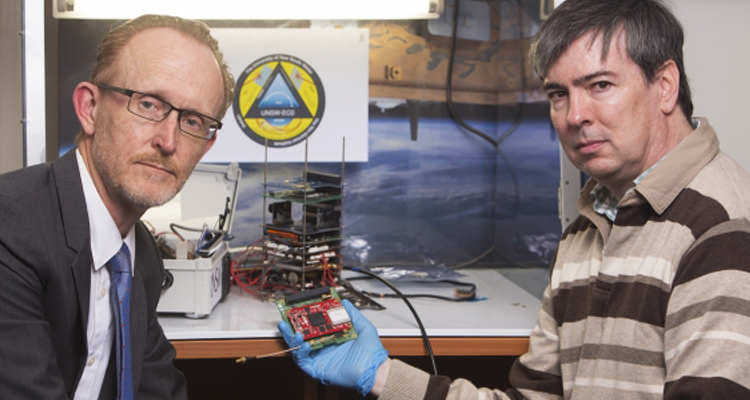
Grant will allow researchers to improve precision of satellite data to benefit a range of industries.
UNSW Engineering researchers have been awarded almost $700k in the first round of federal government International Space Investment – Expand Capability grants.
The grants are designed to build the capacity and capability of Australia’s space sector and support Australian businesses and research organisations to collaborate with international space agencies or established international space programs. Only 10 grants were awarded in this round from more than 100 applications.
Professor Andrew Dempster, Director of the Australian Centre for Space Engineering Research (ACSER), will manage the grant for the project ‘Advanced Global Navigation Satellite System (GNSS) Receiver for CubeSats, Rockets and Remote Sensing’ announced yesterday by the Minister for Industry, Science and Technology, Karen Andrews.
Prof. Dempster is a leading Australian space expert, specialising in satellite systems and communications, including global navigation satellite systems (GNSS), remote sensing and signal processing. He said his senior research associate Dr Eamonn Glennon will use the grant to upgrade their single frequency global positioning system (GPS) receiver, called Kea, to be capable of use with multiple frequencies, antennas and systems.
“This grant is very timely, because it will allow us to fly a far more sophisticated instrument on upcoming satellite missions,” Prof. Dempster said.
GNSS receivers help provide services to a variety of users using signals transmitted by constellations of satellites in space. Defence, maritime, building, mining, logistics and agriculture industries, plus personal consumers of mobile navigation services, all rely on the data made possible by this technology.
Prof. Dempster said that upgrading Kea from a single frequency GPS receiver to a multi-frequency, multi-system receiver will greatly improve the accuracy of the positioning information it provides.
“If we can listen to more systems, we can use the receiver for new applications, such as GNSS reflectometry. This satellite remote sensing technique uses GNSS signals reflected from the Earth’s surface to estimate environmental conditions over the sea and land. It’s used to monitor wind direction and speed over the ocean and the height of waves, which helps maritime planning. It’s also used for flood management and other passive radar and remote sensing applications,” he said.
“The upgrade will also improve how we monitor the Earth’s ionosphere, which affects satellite communications. A multi-signal [frequency] receiver will allow us to better understand the ionosphere, and therefore space weather, which affects satellite communications for uses such as live sports broadcasts, defence and NBN sky muster internet provision in remote areas.”
ACSER’s Kea and Namuru (an earlier model) are the only ‘flight-proven’, locally made GPS receivers in Australia and New Zealand. Prof. Dempster’s team has already flown them on four satellite missions: UNSW’s UNSW-EC0, INSPIRE-2 developed with Sydney University and the Australian National University, and two missions with Defence Science and Technology (DST) Group. The UNSW team is also working on upcoming defence missions and with rocket launch companies to put the receiver on rockets.
“The advancements we’ll make, thanks to this funding, will ensure our GPS receiver is competitive with others on the market, which are currently imported. We’ll be able to provide local customers with improved devices at a lower cost than imports. There will also be potential to export it,” Dr Glennon said.
“A range of Australian industries will benefit from improving locally owned and operated GPS receiver technology. Satellite and rocket operators will benefit from more accurate positioning of their platforms. Maritime operators will be able to plan routes more efficiently and safely. Satellite communications operators will have better measurements of space weather. There will also be various applications for defence related to passive radar systems.”
UNSW Pro Vice-Chancellor (Research) Professor Ana Deletic welcomed the move by the federal government to expand the Australian space sector.
“Space is a growing, multi-billion dollar industry and Australia needs greater investment in research and technology in this area if we expect to compete in this market,” she said.
“Prof. Dempster is a leading Australian space technologies expert, and I am excited to watch his team’s developments made possible by this grant over the next two years.”
Industry partners in the project are Seaskip Pty Ltd, Embedded GNSS and New Zealand’s General Dynamics. The New Zealand Space Agency is also a partner.
- Log in to post comments
